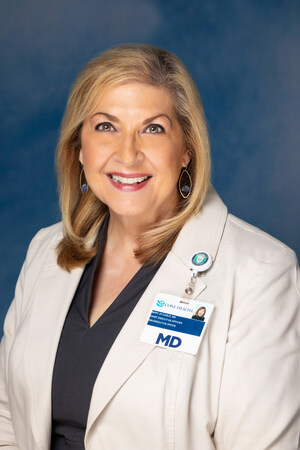OAKLAND, Calif., Feb. 20, 2017 /PRNewswire/ -- Kaiser Permanente, the largest integrated health system in the nation, led the development of a neonatal sepsis risk calculator that has safely reduced antibiotic use by nearly 50 percent in newborns, according to research published today in JAMA Pediatrics.
Early-onset neonatal sepsis is a systemic bacterial infection that can develop when normal bacteria from the mother's gastrointestinal or genital tract causes an infection in her baby. These infections can be very dangerous in newborns and can result in meningitis or even death.
Since the introduction of routine Group B streptococcus screening and intrapartum antibiotics for at-risk mothers, which is recommended by the Centers for Disease Control and Prevention, the incidence of early-onset sepsis has fallen to less than 0.8 per 1,000 births in 2014. Despite this low incidence, about 15 percent of babies are still evaluated for infection by blood culture and 5 to 8 percent receive antibiotics while they are waiting for infection to be ruled out.
"It's often unsettling for new parents to have their newborn's blood drawn or have their babies taken to the neonatal intensive care unit shortly after birth for intravenous antibiotics," said Michael Kuzniewicz, MD, MPH, the study's lead author, a practicing neonatologist and director of the Perinatal Research Unit at the Kaiser Permanente Division of Research. "We thought there must be a better way to decide which infants were at higher risk, and only evaluate and treat those infants."
The innovative, risk-based approach better targets newborn infants who are at the highest risk for a serious bacterial infection without exposing those at low risk for infection to antibiotics.
Researchers at Kaiser Permanente, the University of Pennsylvania and the University of California, San Francisco, developed a risk prediction model based on data from more than 600,000 babies and their mothers delivered at hospitals in Boston and Kaiser Permanente facilities in Northern California. The result was an online sepsis risk calculator that clinicians can use to help them decide which infants to evaluate and treat for infection. The calculator uses gestational age, time from membrane rupture, maternal temperature and GBS testing results, and use of intrapartum antibiotics to calculate the risk of early-onset sepsis.
In the study, Dr. Kuzniewicz and colleagues compared a baseline period, when care was guided by CDC guidelines (2010 to 2012), to full implementation of the risk calculator at Kaiser Permanente's Northern California birthing centers (June 2014 to December 2015). During the calculator period, in which more than 56,000 infants were born at Kaiser Permanente hospitals in Northern California, blood cultures to evaluate for infection declined 66 percent, from 14.4 percent at baseline to 4.9 percent. Antibiotic use declined 48 percent, from 5 percent at baseline to 2.6 percent.
"An obvious concern with significantly reducing the percentage of infants receiving evaluations for sepsis at birth or empiric antibiotics is missing a baby with a real infection," Dr. Kuzniewicz said. The study found no increase in readmissions for early-onset sepsis or an increase in antibiotics given at 24 to 72 hours after birth, and the rate of early-onset sepsis was unchanged (0.2 to 0.3 per 1,000 births).
"By dramatically reducing the use of antibiotics, the risk calculator allows mothers and babies to stay together in the days after birth," said co-author Allen Fischer, MD, director of neonatology for Kaiser Permanente in Northern California. "Instead of admission to the neonatal intensive care unit for intravenous treatment, the babies remain with their mothers, which improves bonding and the initiation of breastfeeding in the first days of life."
Research has suggested that there may be an association between early exposure to antibiotics and an increased risk of asthma, obesity and autoimmune disorders later in childhood, Dr. Kuzniewicz said. "Antibiotic treatment has risks and benefits, and administration of antibiotics to uninfected infants mean they only assume the risks."
Use of the calculator has begun to expand outside of Kaiser Permanente, with similar results. Co-author Karen M. Puopolo, MD, PhD, neonatologist and medical director of Children's Hospital of Philadelphia (or CHOP) Newborn Care at Pennsylvania Hospital, the city's largest perinatal center, said Kaiser Permanente's calculator was implemented as the primary means of newborn sepsis risk assessment in July 2015. "Since that time, antibiotic use has declined by about 50 percent, and our team is now leading an effort to implement the calculator in all 11 birth hospitals affiliated with CHOP."
Clinicians in 189 countries accessed the calculator about 250,000 times in 2016. Users are primarily located in the United States, but other major users include clinicians in Australia, Canada, the United Kingdom, India, Holland, Chile and Israel.
The study further demonstrates the ways the analysis of big data collected from Kaiser Permanente's electronic health record system, one of the largest private systems in the world, can aid in the development of risk prediction tools that lead to direct improvements in patient care.
"Our work highlights the critical role of implementation strategies and systems, which allow the promise of predictive analytics to be fulfilled," said senior author Gabriel J. Escobar, MD, regional director for hospital operations research at the Kaiser Permanente Division of Research.
In addition to Drs. Kuzniewicz, Fischer, Puopolo and Escobar, co-authors were Eileen Walsh, RN, MPH, Sherian Li, MS, and Patricia Kipnis, PhD, Kaiser Permanente Perinatal Research Unit; and Thomas B. Newman, MD, MPH, University of California, San Francisco, Department of Pediatrics.
About the Kaiser Permanente Division of Research
The Kaiser Permanente Division of Research conducts, publishes and disseminates epidemiologic and health services research to improve the health and medical care of Kaiser Permanente members and society at large. It seeks to understand the determinants of illness and well-being, and to improve the quality and cost-effectiveness of health care. Currently, DOR's 550-plus staff is working on more than 350 epidemiological and health services research projects. For more information, visit www.dor.kaiser.org or follow us on Twitter @KPDOR.
About Kaiser Permanente
Kaiser Permanente is committed to helping shape the future of health care. We are recognized as one of America's leading health care providers and not-for-profit health plans. Founded in 1945, Kaiser Permanente has a mission to provide high-quality, affordable health care services and to improve the health of our members and the communities we serve. We currently serve more than 11.3 million members in eight states and the District of Columbia. Care for members and patients is focused on their total health and guided by their personal physicians, specialists and team of caregivers. Our expert and caring medical teams are empowered and supported by industry-leading technology advances and tools for health promotion, disease prevention, state-of-the-art care delivery and world-class chronic disease management. Kaiser Permanente is dedicated to care innovations, clinical research, health education and the support of community health. For more information, go to: kp.org/share.
For more information, contact:
Heather Platisha, [email protected], 415-262-5992
Janet Byron, [email protected], 510-891-3115
SOURCE Kaiser Permanente
Related Links
WANT YOUR COMPANY'S NEWS FEATURED ON PRNEWSWIRE.COM?
Newsrooms &
Influencers
Digital Media
Outlets
Journalists
Opted In






Share this article